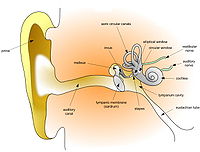Ear


The ear is the part of the body which allows animals (including people) to hear. People and most mammals have ears. Non-mammals, such as lizards or frogs, can also hear, but may have holes instead of external ears. The ear works by directing sound waves to the inner ear. These vibrations are sent to the brain by an organized group of nerves. This system is called the auditory system. (Auditory meaning relating to hearing and how we hear)
The inner ear is in most vertebrates, but mammals have special adaptations for hearing which even other land vertebrates do not have. These include the external ear and the three little bones which transmit sounds to the brain (the ossicles). The part of the ear that sticks out and can be seen is called the pinna.
Ears are also used in other ways. African elephants use their large ears to cool themselves when it is very hot. Bats rely on their ears to find prey by echolocation. Some animals use their ears for signalling to each other.
Other hearing
[change | change source]In ordinary language, "ear" refers to this receptor which conducts sound and sends signals to the brain. It does not refer to the many other methods of hearing found in fish and invertebrates. Many animals do not hear through ears. Spiders have small hairs on their legs that they can hear with.
Related pages
[change | change source]
